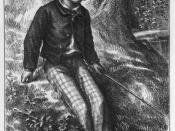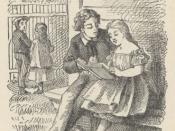The illustrations included within a book set forth a telling narrative to the time period of a book's publication in addition to representing the temporal setting the author envisioned. Tom Sawyer, written by Mark Twain in the late Nineteenth century incorporates myriad fanciful illustrations that depict exactly this. In a way, the drawings have become just as treasured as the text itself. The original illustrations of Tom Sawyer give the readers insight into illustrator's interpretation of the book along with the biases, observations, and ethics of the time period.
The large frontispiece portrays a casual scene of Tom relaxing on what looks to be a calm and beautiful day. His sloppy manner of dress suggests at his roguish nature and love of the outdoors. He wears a sun hat and no shoes, hinting that his home, the setting of the book, receives sunshine year-round and has many leisurely activities for mischievous young children such as Tom.
The fishing pole Tom holds in his hand further exemplifies Tom's love of nature. His relaxed body and serene face bring to mind a renaissance-style angel, quite the opposite of what we know about Tom. The illustrator clearly held a high opinion of Tom's playful character. He saw the goodness in all children like Tom but perhaps wanted to convey that the most devilish of children can have the face of an angel as well.
The first three pictures in chapter one, entitled "Tom at Home," "Aunt Polly Beguiled," and "A Good Opportunity" show Tom in his natural element. The first image shows Tom strolling aimlessly down a dirt road leading out of a quaint town, presumably the one from which he hails. Nothing in the town appears out of the ordinary, it is the quintessential boring mid-western town. In fact, the lazy town...

